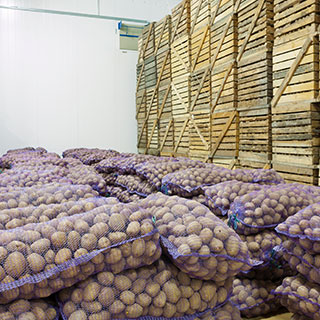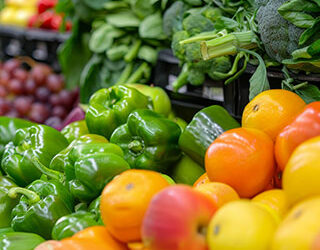Feeding the Future: Rethinking Cold Storage for Haryana’s Potato Economy

Each year, International Day of Potato celebrates the global significance of the potato, an essential crop that feeds over a billion people and supports rural livelihoods. The third most important food crop after rice and wheat in terms of human consumption globally, it plays a critical role in food security and economic stability, with India ranking second in potato production after China.
Potatoes are a significant trade commodity in India. As per the Agricultural and Processed Food Products Export Development Authority (APEDA) report, in FY 2023-24, the country exported over 4.7 lakh metric tonnes of potatoes, mainly to Nepal, Sri Lanka, the UAE, and Bangladesh, while continuing to import high-quality seed potatoes from Europe. This highlights both the rising global demand for Indian potatoes and the persistent domestic gaps in agricultural infrastructure, such as cold storage, seed development, and value chain efficiency. While India is capable of producing surplus quantities for export, the reliance on imported seeds reflects limitations in domestic R&D, quality assurance, and storage systems needed to consistently meet international standards.
As per the NABCONS 2022 report released by the Ministry of Food Processing and Industries, India loses up to 6% of its potato crop due to inadequate post-harvest infrastructure, especially cold stores and transport. Although potatoes can be stored longer than some perishables, they remain vulnerable to rot, sprouting, and distress sales without proper storage conditions.
Haryana: A Case Study in Infrastructure Gaps
Haryana, the seventh-largest potato-producing state in India, yields around 0.8 million metric tons annually, with Kurukshetra, Karnal, and Yamunanagar leading in output. Its strategic proximity to Delhi-NCR provides it with superior access to major markets, logistics hubs, and export infrastructure. This connectivity enhances its potential as a cold chain node, making it an ideal region to demonstrate scalable, energy-efficient cold storage models.
A major bottleneck in the state’s agricultural value chain is its outdated cold storage infrastructure. Despite having 382 cold storage units with a combined capacity of 0.87 million metric tonnes (2.2% of India’s total), nearly 90% are legacy facilities – single-commodity, energy-inefficient units that primarily serve potatoes. These units remain underutilised during off-seasons, fail to support other perishables, and contribute to high operational costs and carbon emissions. For many smallholder potato farmers, the lack of modern, reliable cold storage leads to distress sales, significant spoilage, and lost income opportunities.
In 2023, farmers in Haryana faced severe price crashes, with wholesale rates dropping to INR 1.25-3 per kg – far below the INR 7-8 per kg cost of production. Without adequate storage, many were forced to sell immediately, triggering gluts and economic distress. These losses also translate into wasted water, energy, and agricultural inputs, adding to the environmental footprint.
A Case for Rethinking Haryana’s Cold Stores
Modernising Haryana’s cold stores is crucial to stabilising farmer incomes, reducing post-harvest losses, and ensuring market access for a wider range of perishable goods. A robust, multi-commodity cold chain also supports food quality, extends shelf life, and enhances export readiness by meeting global standards for traceability and consistency.
Technological upgrades – such as solar-powered cooling, thermal storage, low-GWP refrigerants, and automated systems – can improve energy efficiency, reduce emissions, and align the food system with Haryana’s climate and decarbonisation goals.
As part of the Mission Efficiency India initiative, in partnership with Sustainable Energy for All (SEforALL), the Alliance for an Energy-Efficient Economy (AEEE) is supporting this transformation. Through policy work, pilot projects, and implementation, AEEE aims to build a sustainable, resilient cold chain aligned with economic and environmental priorities.
Pathways to Strengthen Haryana’s Cold Stores
- Encourage multi-chamber, multi-commodity cold stores to improve year-round utilisation and reduce food waste across diverse crops.
- Empower farmer groups and cooperatives to jointly invest in and manage storage infrastructure, improving access for smallholders.
- Leverage government support schemes, such as the Agri Infrastructure Fund, PM Kisan Sampada, and Operation Greens, to build or retrofit cold stores with energy-efficient systems.
- Promote training and awareness on post-harvest management, clean cooling practices, and market-readiness strategies to maximise infrastructure impact.
Feeding the Future Begins with Building a More Sustainable Storage
The potato may be a symbol of resilience, but the systems that support its journey from farm to fork must evolve. For Haryana’s farmers, the cold store gap represents both a barrier and a chance to unlock greater value.
As highlighted by the 2025 World Potato Day theme, “Shaping History, Feeding the Future,” rethinking how we preserve and store our food is central to building resilient, inclusive, and climate-aligned agricultural economies. Building a cold store that truly works for Haryana means more than just adding storage, it calls for smart infrastructure, clean energy, and empowered institutions to drive both farmer prosperity and sustainable growth.
Disclaimer: The opinions expressed in this article are those of the authors and do not purport to reflect the views of AEEE
This blog is written by – Ranjana Kumari




